1937 Alvis Speed 25 Offord
Is this unique Alvis Speed 25 the finest-looking British car of the Thirties? It has a strong claim to that title, and after years of careful refinement, it’s one of the best to drive, too.
Words NIGEL BOOTHMAN
Photography LAURENS PARSONS
As elegant as any French art-deco: Offord’s Alvis Speed 25
An Offord You Can’t Refuse Is this special Alvis Speed 25 Britain’s most elegant tourer?
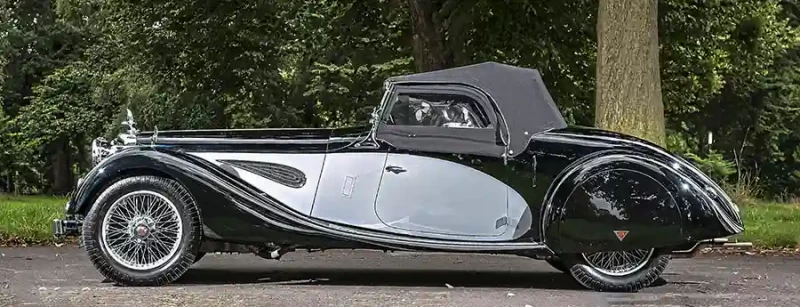
You can tell this car is something special at a glance, and the more you learn about it, the more your first impression is proved right. It’s the only Alvis Speed 25 with this glamorous Offord ‘hidden top’ roadster bodywork. It is also the only Speed 25 built as a two-seater, not counting the various specials created in later decades. Come to that, it’s not purely a Speed 25 at all, because it’s no longer running a Speed 25 engine. The original 3.5-litre unit disappeared, possibly in occupied territory during the war, and after peace came it was fitted with a new 4.3-litre unit acquired directly from Alvis. Since then, it’s been through various adventures on both sides of the Atlantic, so it’s had something of a past.
‘This glamorous car just does not belong on the A38 on a blustery Thursday morning in 2024. It’s like seeing Lauren Bacall in the chip shop’
Back in the present, we have this wonderful opportunity to drive it. The car is looked after by Fisher Restoration, which has a workshop here on the Chateau Impney estate near Droitwich Spa, Worcestershire. The car has been busy recently, traversing Europe to attend concours events and adding to the impressive mileage covered in its current long-term ownership. Back in the UK, it’s been up to Scotland for the Alvis Owner Club’s International Alvis Day at Crieff Hydro, too. It should be fit, then. Retard the ignition with the left-hand control on the steering wheel boss, flick the ignition key over, press the starter. It catches immediately and settles to a brawny, bass-rich idle, so we can advance the ignition and leave it there. There are two other quadrant controls on the steering wheel, one for the lights and the other is a hand-throttle, beautifully set up for keeping the big overhead valve straight-six happy as it warms. Each click on the pawl makes an audible difference to the engine speed.
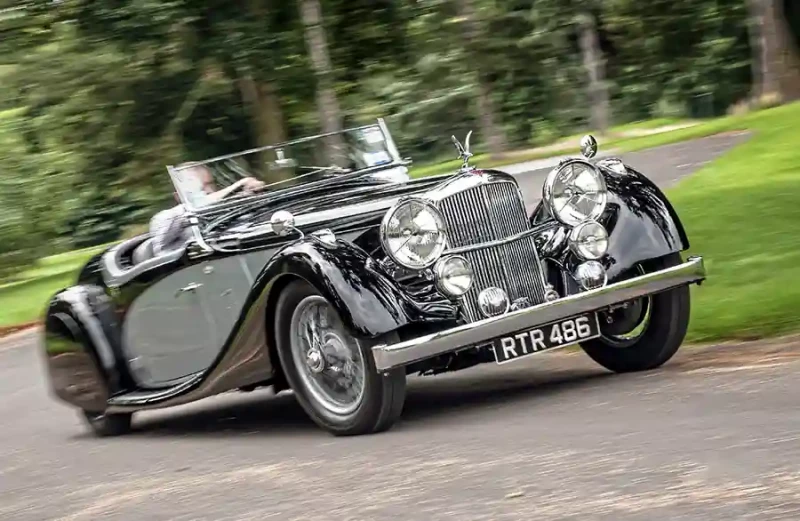
Into first. The clutch is gentle and takes up drive smoothly with no need for leg-trembling care, while the famous Alvis allsynchromesh gearbox slots home through second, third and top with its usual silent ease, at the end of long-ish throws of the lever. I pull out onto the Worcestershire A-roads and within a few hundred yards, it’s obvious what a successful job has been done in sorting this example. I’ve driven seven or eight Alvis Speed 25 and 4.3-litre cars, and they are always charismatic and exciting but are tricky to get 100% right. Adjustment of brakes, suspension, steering and the way they all combine with coachbuilt bodies on flexible chassis can be cruelly exposed by British road surfaces. Not so here.
It feels collected, well balanced and fast. This Alvis pulls strongly from 25mph in top gear; that is not nursing it away but accelerating hard. Even with a recommended rev limit – some belt-and-braces engine work is coming up eventually – there is a lot of fun to be had, as 60mph in top is only 2500rpm. Indeed, the Alvis is right in its happy place between 45 and 65mph in that one gear, surging away from traffic as you leave a 40mph zone.
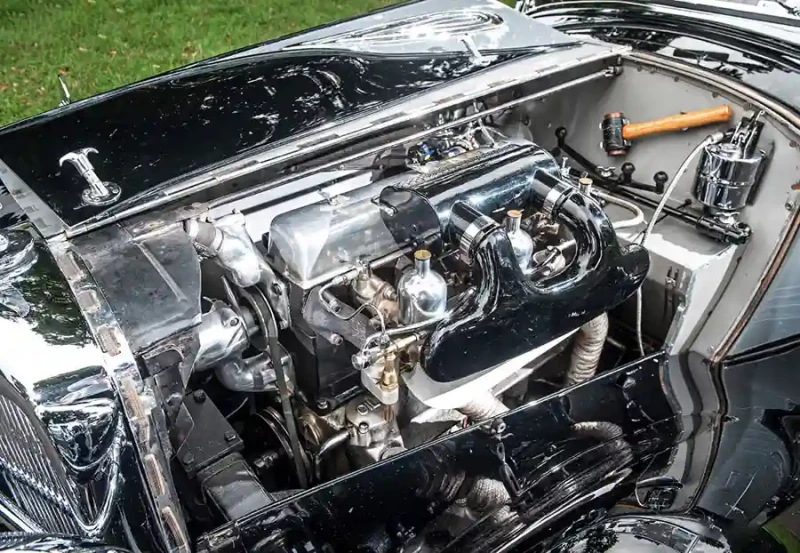
4.3-litre ‘Blitz engine’ came from Alvis works.
I soon find myself pulling out to pass dawdling vans without needing to change down, though a drop to third does produce an exciting exhaust growl and a roar as the big SU carburettors draw air. Any 4.3-litre Alvis with a touring body was reckoned to be a 100mph car when new, and it feels totally plausible. Yes, you’d need a long road to overcome the Thirties aerodynamics, but you’d only be turning a little more than 4000rpm at the ton. The brakes are powerful and can catch you out at low speed, which is the nature of large servo-assisted drums, so it’s easy to be inelegant as you come to a halt. At proper speeds, they feel more progressive so you soon realise it’s the size of the contact patch on these tall, narrow tyres that will limit you, not the brakes themselves. Even more impressive is the engine’s behaviour – it’s not easy to smooth out three large carburettors – helped by a starting carb – and these big Alvises rarely show the silkiness you’d expect from a twin-carburettor Derby Bentley. The Alvis makes up for it with performance.
It has certain advantages over some contemporaries: independent front suspension and that all-synchro ’box, as well as the adjustable Luvax dampers and Bijur centralised chassis lubrication typical of cars in this class. Long, sweeping left and right bends show it off to perfection. One front wheel hits a bump in mid-corner; a less well-sorted example would start a horrid front-end shimmy that would have you backing off, whiteknuckled at the wheel to keep it on line, but this lovely machine just eats it up and carries serenely on. A dual carriageway is less delightful, with dust and diesel fumes whirling in over the windscreen, but it gives us a chance to observe other people’s reactions. Bafflement, mainly. No looks of recognition, one or two smiles, but mainly a kind of blankness. Whatever it is, this glamorous car just does not belong on the A38 on a blustery Thursday morning in 2024, surrounded by bulky SUVs and articulated lorries. It’s like seeing Lauren Bacall in the chip shop. Even in 1938 it was enough of a head-turner to become the subject of a small article in The Autocar on bespoke coachwork. Chassis 14557 was ordered and completed in 1937 and delivered to Mr F A Thomas, president of the Institute of Consulting Engineers. He had commissioned this one-off body from the London coachbuilder Offord, but who it was at Offord who drew such a superbly attractive shape has proved hard to discover. By the time current owner James Sprague investigated the topic, the last of the Offord family was in a care home, and no longer able to recall details of work from the Thirties.

Offord was unusual among inter-war coachbuilders; for some years after a near-bankruptcy in 1923 it built almost nothing, completing only design work and having the bodies constructed by other coachworks such as Harrison and Carlton – and passing it off as its own. Quite how much of its output, even in the late Thirties, really originated from the firm’s West End works is hard to say. Certainly, two of the eleven Alvis 4.3-litres credited to Offord are known to have been built by Carlton. Nick Walker states in his A-Z of British Coachbuilders that ‘Offord was effectively offering a bespoke design service on upmarket British and American chassis.’ In the Thirties it also built standard, catalogued bodies for a few marques, but perhaps that status as a purveyor of truly individual, one-off creations persuaded Mr Thomas to give it a try. Or he may have been sufficiently impressed by Offord’s standard drophead-coupés on Alvis chassis to approach it with his own requirements.
As a piece of design, there are so many features to pore over: elegant ovoid forms that swirl and slash, echoing each other as black paint tries to out-glimmer the brightwork. Yet in person, it’s not the detail work so much as the overall proportions that strike you. The short, pert tail has a high stance that has nothing to do with spring choice, it’s down to the poise of the body on the chassis – the wheels fit perfectly in the arches. Of course, it makes a successful job of the stowaway hood, a decent-sized boot and roomy front seats by sacrificing the two rear seats on a wheelbase shared with four-seater cars. But then think of other two-seater efforts on four-seater wheelbases, particularly from the Twenties and Thirties – such cars are often ungainly. This one is so neat you wonder whether someone’s been cheating and has lopped a foot from the wheelbase. But they haven’t.
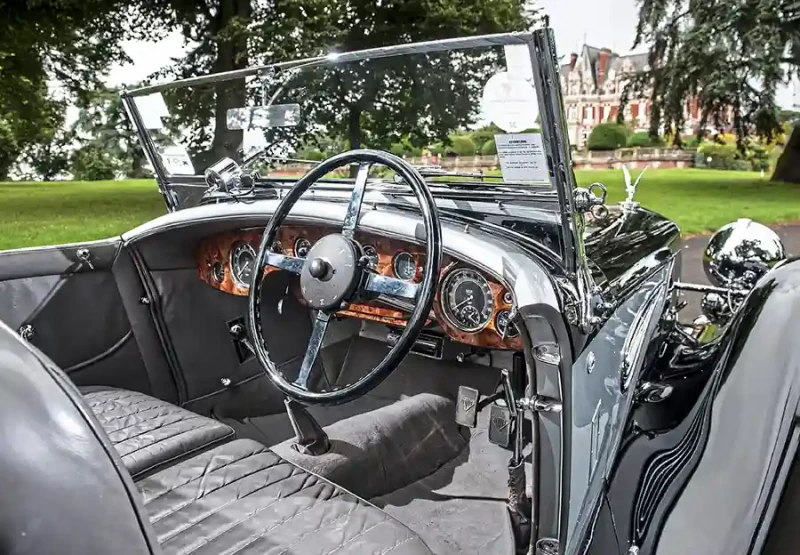
The colour scheme is hugely important too. Black and silver is probably as suitable as can be, though other dark two-tone schemes could also work on such a decorative design. When James Sprague first saw the car, it was yellow and iridescent blue, which on an attention-grabbing, heavily styled body takes the whole effect well over the top.
But we’re getting ahead of ourselves. Chassis 14557 was in Jersey when the Channel Islands were invaded and occupied in June 1940. There was a tale from a previous owner that suggested the car’s engine was removed by German forces in charge of the island, but with no evidence to back this up, all we know for sure is that the Alvis’s original engine was replaced sometime before 1956, when it found a new owner in Southampton. This new engine, though, is interesting.
The Alvis car works ‘copped a packet’ in the Blitz and a great deal was destroyed, though a batch of 4.3-litre engines survived. These were destined for cars yet to be built when the bombs came. The engine fitted to this car was number 15366, which is believed to be one of the ‘Blitz’ engines; we know it was fitted to no other car before this. Such a job would very likely have been done at the factory or in the London service depot. The car left Jersey for good in 1956 and was spotted by a student at the University, Bob Kellock, who caught sight of it in Southampton docks when it was painted ‘tomato red and silver’. He bought it and re-registered it from Jersey plates to a UK number, RTR 468.

Perhaps such an eye-catching car had a rapid effect on his relationships, because he soon sold it to a university lecturer to fund a marriage. A few years later it had been sprayed black again and almost rebuilt by the Alvis works; it also had a crash with an ambulance and was pictured in a magazine article outside a workshop in Lancaster Mews, London. It was later sold, in 1961 or ’62, to an American who had been looking for a Rolls-Royce and found nothing he could afford. It changed hands several more times over the years, eventually undergoing another repaint to that garish yellow and blue.
It was in 1994 that James Sprague first saw the car. Some years before he had bought an Alvis TE21 first owned by Tony Curtis and enjoyed it, but was curious about owning an older model. Then he heard from Wayne Brooks, the Alvis historian with a special interest in Speed models and the 4.3-litre in particular. ‘Wayne said there were two cars for sale, a rough Speed 25 tourer and this car. The owner of the Offord car was located near Reno, Nevada, and had bought it perhaps with an eye on Pebble Beach, but he was put off when he was unable to reunite the car with its original engine. It ran okay, but there wasn’t much oil pressure and there was anti-freeze in the oil.’ Despite these offputting features and the car’s peacock-like paint scheme, James bought it and embarked on a brave program of works.
‘It had been restored before in Tulsa, Oklahoma, going to yellow and blue – the owner had spent a lot, but it was not attractive. The engine had to come apart, and it was too much for one mechanic, but eventually I found someone to do it; it meant new white-metal bearings and various other mechanical jobs. Then there was the body – it wasn’t rotten, but the glue had dried out and parts of the ash frame were working loose, so it needed some woodwork to secure the structure.’
When the car could finally be painted, James chose the current black-and-silver colour scheme having seen something similar on a Bugatti, and felt relieved that he liked it. After all, the Alvis Car Record states the original paint was also black and silver, with silver leather.
‘We got it together in mid-2000 and it’s been on the road ever since,’ says James. ‘I’ve used it a lot – it’s on its fourth set of tyres.’ There have been hiccups along the way, and as both James and Steve Wilson of Fisher Restorations (see boxout) admit, with the way the Alvis’ suspension, steering and brakes interact taking time to understand and perfect. But there is no hiding the car’s eye-widening looks, and adventures on the concours field have produced a cabinet full of trophies.
‘We went to Amelia Island in 2002,’ says James. ‘It got a prize for being the car that Dan Gurney most wanted to drive around Napa. Then it won Best Open Car at Pebble Beach in 2002.’ The car has since been invited back to Pebble and took second in its class, having enjoyed a fantastic 1500-mile drive down to the Monterey Peninsula from Seattle, Washington, spread over a week. More recently it’s been rewarded for being the oldest car on tour at Villa d’Este, it’s won a Second in Class at Hampton Court and in September 2023, it was first in class at Salon Privé. ‘Many people have said to me, “I’ve never seen an Alvis bodied by a European coachbuilder before,”’ says James. ‘They’ve never seen a British car that looked like this, and they assume it must have a French or Italian body.’
It would be easy to assume it’s by Figoni & Falaschi, Fernandez & Darrin, Gangloff or Chapron, even though we had legions of coachbuilders in the UK with the ability to produce stunning works on the best chassis of the era – look no further than the dozen Alvis 4.3-litre Vanden Plas short-chassis Tourers. But there are not a dozen Offord two-seaters with the disappearing hood, there is only one. Just imagine what a fuss people would make of it if the badge on the front were not Alvis, but Bugatti or Alfa Romeo, Mercedes or Hispano-Suiza.
Sometimes we don’t give enough credit to our home-grown glamour. This is as fine a piece of automotive art as anything built in that golden era of the grande routière – and you can bet it’s a far better car to drive today than most of its rivals ever were.
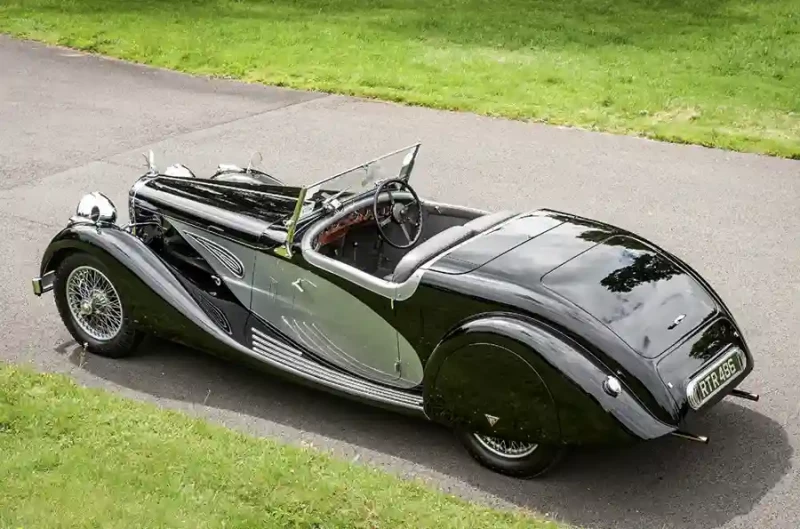
Thanks to: Chateau Impney estate, Fisher Restoration (fisherrestoration. co.uk, 01299 251628), Wayne Brooks, David Culshaw, James Swan. If anyone can add to this car’s early history, please contact the magazine Subscribe to Classic Cars from just 99p at greatmagazines.co.uk/classic-carsmagazine
TECHNICAL DATA 1937 Alvis Speed 25 Offord
- Engine 4387cc inline six-cylinder, ohv, three SU BS5S carburettors
- Max Power and torque 137bhp @ 3600rpm; torque n/a
- Transmission Four-speed all-synchromesh manual, rear-wheel-drive
- Steering Marles L7 steering box, worm and roller
- Suspension Front: independent by lower wishbones, upper transverse leaf spring, Luvax adjustable lever-arm dampers. Rear: live
- axle, leaf springs, Luvax adjustable lever-arm dampers
- Brakes Front & rear: servo-assisted drums
- Performance* Top speed: c. 105mph
- Acceleration 0-60mph: 11.3sec
- Weight* 1930kg (4256lb)
- Fuel consumption* 15-16mpg
- Cost new VdP 4.3
- Tourer: £995, perhaps £1250 for one-off Offord roadster
- Classic Cars Price Guide £170,000 for standard Speed 25 tourer; c. £400,000 for a shortchassis VdP 4.3 tourer, this car in excess of that figure *figures from 4.3-litre VdP tourer
A car to gaze at – new shapes and details emerge. Stereo well hidden – good for long trips. Grandes routières don’t get much better to drive. Knob for deadlock; suicide doors cannot fly open. Potent six-cylinder nestles behind transverse-spring independent front suspension Knob.
Sorted suspension alllows for bold. Not a very famous name, but a fine choice for one-offs cornering speeds. Lucas P100 lamps the only suitable choice. Stowing hidden roof is easier with two.
Two-seat cabin is snug with roof up; nicer without sidescreens.
‘Imagine what a fuss people would make of it if the badge on the front were not Alvis, but Bugatti, Alfa Romeo or Mercedes-Benz’
LOOKING AFTER A ‘SPEED MODEL’
Steve Wilson of Fisher Restoration doesn’t mind admitting this car is a favourite, and he looks after plenty of other gorgeous Thirties Alvises. A challenging job? ‘This one is more of a challenge than some other Speed 25s or 4.3s, yes. It’s the only one of its type, so it’s really a prototype and like all prototypes, it’s not practical. For instance, to get the engine or clutch out, you have to take the front wings off, which are one piece and go under the radiator. There’s a lot of form over function and it can be a bit of a pain to work on. But it’s easy to forgive! I just have to look at the air vent in each bonnet side…
‘These big Thrities Alvises are well supported by the Alvis Owner Club and some excellent specialists, but you need to know what you’re doing, mechanically. They have some unusual features in the way they’re put together – using nine valve springs on each valve, having the timing gear at the back of the engine, an oiling system it’s possible to assemble wrongly during an engine rebuild, that sort of thing. On the Offord car, it suffered a vibration ever since James had it rebuilt, and we eventually discovered an imbalance in the flywheel, clutch housing and crankshaft. To get to that took a total stripdown, and it was because someone had built it up 180-degrees out.
‘But if the basics are right, it’s just a case of making sure nothing is worn in the running gear and it’s all properly adjusted. The brakes need careful set-up, which we worked hard to get right when we first saw the car. James had previously cured nasty wheel tramp by fitting brand new wheels; the originals were so far out of true that balancing wasn’t enough. They’re tough, nicely engineered machines; our guys know them well and really enjoy working on these Alvises.’


